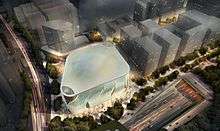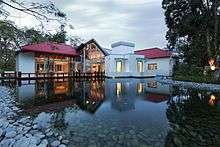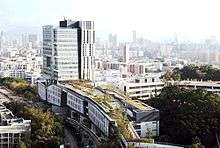Ronald Lu and Partners
Ronald Lu & Partners (RLP) is a Hong Kong architecture and interior design firm founded by Ronald Lu in 1976. The practice provides architecture, interior design and master planning services in various sectors including culture and community, education, mix-used, commercial, residential, hotel and retail, transit-oriented development.
It is headquartered in Hong Kong with four offices in Beijing, Shanghai, Guangzhou and Shenzhen.
History
Ronald Lu & Partners was established in 1976, founded by Ronald Lu in Hong Kong. It is a design-led firm providing services mainly in architectural design, interior design and master planning. It first started with small housing projects and now participates in various larged-scaled, mix-used developments locally and internationally. Projects include West Kowloon Cultural District Conceptual Plan, Chinese Opera House, revitalisation of the Peak Tower, Hong Kong Disneyland Hotel, City University of Hong Kong Academic Building III, China Resources Building, Hong Cheng Plaza Guangzhou and Shanghai Minhang Xinzhuang Comprehensive Development.[1] RLP now has over 550 staff across its Hong Kong headquarters and four mainland China offices in Beijing, Shanghai, Guangzhou and Shenzhen.
Notable projects
China Resources Building
China Resources Building is a mix-used grade A office, retail and hotel complex located at Harbour Road, Wan Chai. It is built in 1983 and renovated in 2012. The refurnished building installed a new curtain wall with double low E glazing and energy efficient external LED lighting system indoor, which largely reduces energy consumption. It is also the first certified renovation project to achieve LEED Core & Shell Gold Rating in Hong Kong.
West Kowloon Cultural District, Conceptual Plan

Located at the wedge-shaped waterfront reclaimed land west of Yau Ma Tei, the West Kowloon Cultural District is an area of 40 hectares, featuring cultural and recreational, public, commercial and residential uses. A 23 hectare public park at the tip provides green open space for the city in a similar fashion style to Hyde Park or Central Park. RLP has worked in collaboration with Foster + Partners as local consultant to produce the winning conceptual master plan for the West Kowloon Cultural District, selected through international competition in April 2011.[2][3]
Chinese Opera Centre, Hong Kong
Bing Thom Architects and Ronald Lu & Partners works with the West Kowloon Cultural District Authority to design the centre for preservation, development and promotion of the important art form of Chinese cultural heritage in Hong Kong. Occupying a prime site of 13,800 square metres at the eastern edge of the district, the centre contains 2,000 square metres of training and education facilities, two auditoria with 1,100 and 400 seats and a traditional tea house for performances with up to 200 seats. The project is scheduled for commission in the end of 2016.[4]
Zero Carbon Building (ZCB)

ZCB, a joint project of Ronald Lu & Partners and the Construction Industry Council and Development Bureau, is the first zero carbon building in Hong Kong, built in 2012 on Sheung Yuet Road, Kowloon Bay Industrial Area.[5] It costs HKD $240 million, covering a total area of 14,700 square metres of land, comprising a three-storey building and a landscape area. It houses seven zones: indoor exhibition and education area, eco-home, eco-office, eco-cafe, multi-purpose hall, eco-plaza, outdoor exhibition areas and Hong Kong’s first urban native woodland. 90% of the site area covers with plants, served as recreational use, 60% of which is planted with local vegetation.
Maggie’s Cancer Caring Centre

Maggie’s Cancer Caring Centre Hong Kong is located in Tuen Mun Hospital, and is the first counseling facility of this kind outside the United Kingdom.[6]
Civil Aviation Department Headquarters
Situated at Chek Lap Kok, Lantau Island near Hong Kong International Airport, the headquarters co-locates Air Traffic Control Centre and all current divisions. It comprises three zones whereas Zone A contains a brand new resources centre, Zone B contains the new air traffic control centre, offices, training centres, meeting rooms and halls and Zone C contains GPS and other facilities.
City University of Hong Kong Academic Building III

In light of the 3/3/4 education reform, a new academic building of City University of Hong Kong is built near the main campus. It consists of 20 storeys covering 20,500 square metres of site area of various facilities including classrooms, teaching and research laboratories, a 600-seat theatre, multi-purpose room, canteen, administration offices and a sky garden.
The Opus, Hong Kong
Opus Hong Kong is a 12-storey, 42.62 m (139.8 ft) residential high-rise completed in 2012 at 53 Stubbs Road on Victoria Peak in Hong Kong, China. The project was designed by Frank Gehry in collaboration with Ronald Lu & Partners. It was Gehry's first Asian residential project. The building consists of 12 residential units which range from 560 to 640 m2 (6,000 to 6,900 sq ft). It is rated BEAM Platinum by the Hong Kong Green Building Council (HKGBC).
Awards
- BEAM Plus Provisional “Platinum”, HKGBC[7]
- BEAM Platinum Awards, HKGBC[8][9]
- The Ring ic@ward International Interior Design
- Champion of HKIE Innovation Award 2012/2013[10]
- Perspective Global Awards[11]
- Asia Pacific Interior Design Award 2012[12]
- Green Building Award 2012[13]
- Hong Kong BIM Awards[14]
- Quality Building Award 2012[15][16]
- The American Institute of Architects Hong Kong Awards[17]
- The Hong Kong Institute of Architects Awards[18][19][20]
- MIPIM Asia Award 2013[21][22][23][24]
References
- ↑ "world architecture 100 2011". worldarchitecture100.com. BDonline. Retrieved 11 November 2013.
- ↑ Archdaily. "Xiqu Centre Winning Design/Bing Thom Architects + Ronald Lu & Partners". Archdaily. Vanessa Quirk. Retrieved 10 December 2012.
- ↑ West Kowloon District Cultural Authority. "Architects Bing Thom and Ronald Lu chosen to design Xiqu Centre.". West Kowloon District Cultural Authority, HKSAR. WKDC, HKSAR. Retrieved 2 October 2013.
- ↑ HKSAR. "Speech by CS at Ground Breaking Ceremony of Xiqu Centre of West Kowloon Cultural District". Hong Kong Information Services Department. HKSAR. Retrieved 24 September 2013.
- ↑ ArchDaily. "ZCB Zero Carbon Building / Ronald Lu and Partners". ArchDaily. Retrieved 18 October 2012.
- ↑ "Landscape design of Maggie's Centre Hong Kong". Maggie's Cancer Caring Centre. Retrieved 2 October 2013.
- ↑ "呂元祥建築事務所 帶領開拓綠色設計". PRC 建設雜誌. 31 July 2013. Retrieved 8 November 2013.
- ↑ "「環保」樓盤設計出自黃錦星手筆". Sing Tao Daily. 3 September 2012. Retrieved 8 November 2013.
- ↑ "紅人熱事—— 屢獲國際環保認證 香港=綠色家園". Headline Daily. 10 September 2012. Retrieved 8 November 2013.
- ↑ "ZCB wins Innovation Award". ARUP. ARUP. Retrieved 12 April 2013.
- ↑ "Perspective Award 10th Anniversary" (PDF). Perspective Global. Perspective Global. Retrieved 8 November 2013.
- ↑ "20th 2012 APIDA Winners List". APIDA. Asia Pacific Interior Design Awards (APIDA). Retrieved 11 November 2013.
- ↑ "Green Building Award Directory". Hong Kong Green Building Council. HKGBC. Retrieved 8 November 2013.
- ↑ "Autodesk Hong Kong BIM Awards 2012 Success Stories". Autodesk. Autodesk. Retrieved 11 November 2013.
- ↑ "Quality Building Award 2012 Winning List" (PDF). Quality Building Award. Quality Building Award. Retrieved 11 November 2013.
- ↑ "Quality Building Award 2012 Building Excellence for the Future Certificate of Merit" (PDF). Quality Building Award 2012. Retrieved 11 November 2013.
- ↑ "Images of awarded projects". American Institute of Architects (HK). AIAHK authorised forum. Retrieved 8 November 2013.
- ↑ "HKIA Annual Award". Hong Kong Institute of Architects (HKIA). Hong Kong Institute of Architects (HKIA). Retrieved 11 November 2013.
- ↑ "List of Past HKIA Annual Awards" (PDF). Hong Kong Institute of Architects (HKIA). Hong Kong Institute of Architects (HKIA). Retrieved 11 November 2013.
- ↑ "Local architects' efforts recognised by the HKIA Annual Awards". The Standard. 23 April 2010. Retrieved 11 November 2013.
- ↑ "Far East's Miro takes top award". Freenewspos.com. 7 November 2013. Retrieved 8 November 2013.
- ↑ "MIPIMアジア・アワード、(MIPIM Asia Awards)、受賞プロジェクトを発表". International Business News. 7 November 2013. Retrieved 8 November 2013.
- ↑ "China and Singapore each win three MIPIM Asia gold awards". Freenewspos. 8 November 2013. Retrieved 11 November 2013.
- ↑ "MIPIM Asia Awards Reveal the Winning Projects". PR Newswire. 5 November 2013. Retrieved 11 November 2013.